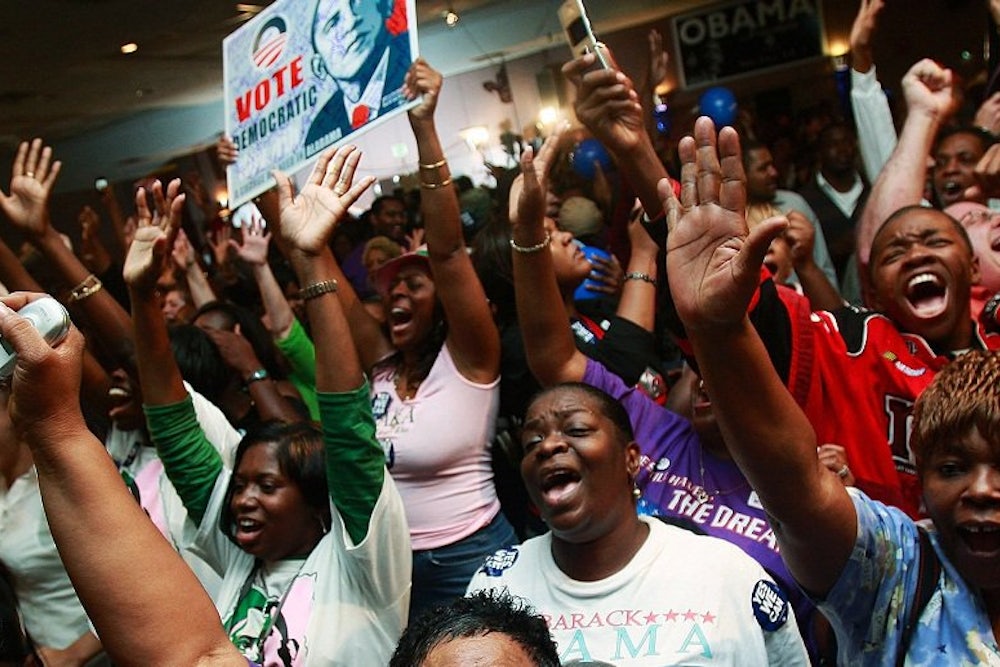After decades dreaming of high black turnout, Democrats finally got their wish in the last two elections, with obvious results. President Barack Obama overcame a strong Republican performance among white voters last November, and Monday, an analysis by William Frey, a demographer at Brookings, found that black turnout actually exceeded white turnout in 2012. He also concluded that Mitt Romney would have won last year if racial turnout levels had mirrored 2004's. Both conclusions are premature—and the latter is plain wrong.
The Associated Press report on Frey's analysis led with the flashy hook that the black turnout rate had exceeded whites' for the first time. That’s probably correct, but isn’t as newsworthy as it seems. Paul Taylor of Pew Research reached the same conclusion by similar means in December, finding that the exit polls and county-level results were consistent with the possibility that black turnout exceeded white turnout in November. As both Taylor and Frey note, these are tentative conclusions until the Census Bureau releases the November Supplement to the Current Population Survey (CPS), which is generally considered the benchmark for judging racial turnout, since it has a larger sample and provides more precise figures than the exit polls. The CPS and the exit polls are imperfect—and, in fact, they have disagreed about the composition of the electorate—but I suspect that the CPS, which could be released as soon as next week, will agree with the exit polls on higher black turnout rates.
Frey’s more original, but problematic, contribution is that Obama would have lost the election if turnout rates had returned to ’04 levels. Although the AP article does not clearly describe the methodology underlying that conclusion, Frey told me in a telephone conversation that he calculated the 2012 results with ’04 turnout levels by estimating the voting eligible population, assuming ’04 turnout based on the CPS, and assuming that demographic groups voted as they did in the 2012 exit polls. Using this approach, Romney wins the popular vote and critical battleground states like Ohio, Virginia, Florida, Pennsylvania, and Colorado.
But there’s a problem: Mixing and matching CPS turnout data with survey results from the exit polls systematically underestimates the president’s performance. The exit polls assume higher minority turnout rates than the CPS; if the CPS is right about lower minority turnout rates, then Obama did better among white or non-white voters, or perhaps both, than the exit polls assume. Frey chose this approach because he believes that the CPS is a more accurate indicator of the composition of the electorate. But by plugging the 2012 exit poll survey data into a CPS-based electorate, Frey conflates the consequences of shifting sources with lower minority turnout rates.
Take the state of Colorado, a relatively white state where Obama won by a large 5-point margin, but where Frey believes Obama would have lost with ‘04 turnout rates. Frey estimates that whites would have represented about 86 percent of the Colorado electorate with 2004 turnout rates; plugging in the 2012 survey results from the exit polls gives Romney a narrow victory. But the 2012 exit polls found that whites were just 78 percent of the electorate—a tally that the CPS is unlikely to confirm. Indeed, Frey estimated that whites represented 80.4 percent of Colorado’s voting-eligible population; since low-turnout Hispanics represent a majority of Colorado’s minority population, the white share of the electorate should be even greater than the white share of the voting-eligible population. Indeed, using 2008 turnout rates from the CPS, Frey would estimate that the Colorado electorate was 84 percent white in 2012. This 2-point gap in the white share of the electorate might be a decent guess at the consequences of elevated minority turnout, but Frey’s mix-and-match approach pegs the gap between the white share of the electorate with ’12 and ’04 turnout rates at a ludicrous 8 percentage points.
This problem repeats itself across the electoral map. In every battleground state mentioned in the article, the 2012 exit polls showed the minority share of the electorate exceeding their share of the voting eligible population. In Ohio, Pennsylvania, and Colorado, the gap is very large. In those critical states, much of what Frey attributes to declining minority turnout rates is just a result of comparing the lower minority turnout CPS to the higher minority turnout exit polls. As you can see, an apples-to-apples approach cuts significantly into Frey’s findings. The CPS doesn’t find a very large gap between the white share of the electorate with ’04 and ’08 turnout rates in the battleground states, with the exception of Virginia.
Although it’s clear that historic black turnout wasn’t essential to the president’s reelection (just ask the states that voted for John Kerry or Al Gore, plus Nevada and Colorado), exactly how much it helped Obama is less apparent. The exit polls and the CPS differ, but according to the CPS, black turnout surged to 65 percent of eligible voters in 2008, up from 60 percent in 2004. That 5 percentage point increase was worth 1.2 million additional voters. Hispanic and Asian turnout increased by 2.7 and 2.6 percentage points, respectively, yielding a combined 700,000 new voters—and “other” races probably drove the tally over one million. Since the president won reelection by more than 5 million votes, and not all of these voters preferred the president, it’s clear that the president would have held on with ’04 turnout rates. Indeed, Frey’s prior analysis of CPS data found that the electorate would have been incrementally more diverse in 2012 than in 2008, even if turnout rates returned to ’04 levels. If the 2012 electorate was as diverse as it was in 2008, Obama still would have won reelection. Unless, of course, you tried to plug the exit poll data into the CPS.
